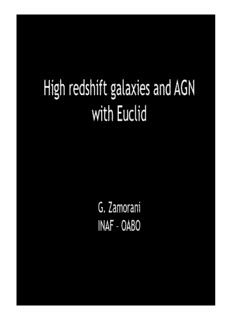
High redshift galaxies and AGN with Euclid PDF
Preview High redshift galaxies and AGN with Euclid
High redshift galaxies and AGN with Euclid G. Zamorani INAF – OABO Legacy science with Euclid • Depth/area combination in the near-ir • High spatial resolution • Large number of spectra Legacy SWGs • Primeval Universe • Galaxy and AGN Evolution • Strong Gravitational Lensing • Clusters • Local Universe • Milky Way and Resolved Stellar Populations • Supernovae and Transients • Exoplanets (microlensing) SV2 Edinburgh Dec 05 The scope of the Euclid near-ir imaging • Wide survey 15,000 deg2 YJH =24 would take AB 680 years with VISTA or 66 years with SASIR (Synoptic All-Sky Infrared Survey - 2017) • Deep survey 40 deg2 YJH =26 would take 72 AB years with VISTA or 7 years with SASIR • The Euclid surveys are >100 times more ambitious than anything underway and at least >10 times more ambitious than anything else currently conceived SV2 Edinburgh Dec 05 Deep fields locations • 40 deg2 YJH 26AB Vis 27.5AB • Default location SEP, NEP • Very strong science case for 6deg2 in Subaru Hypersuprimecam deep fields • 3deg2 in SXDS/UDS 2h18m-5o • 3deg2 in COSMOS 10h00m+2o • Remainder split between SEP, NEP • Advantage of NEP is Hypersuprimecam access for deep z imaging • Advantage of SEP is ESO access Euclid legacy in numbers Euclid spectroscopy Euclid spectroscopy High-z quasars with Euclid z=7.085 quasar Mortlock et al. 2011 2x109Msol BH Lya transmission profile resembles damping wing of the IGM with neutral fraction f>0.1. But reionisation predicted to be inhomogeneous process (Mesinger and Furlanetto 2008). High-redshift quasars Predictions for future surveys 6.4<z<7.2 Survey Area Depth Y Number complete (Vega) UKIDSS 3800 19.6 6 2012 VIKING 1000 20.8 9 2015 PanSTARRS 20000 19.6 33 2015 10 sigma
Description: